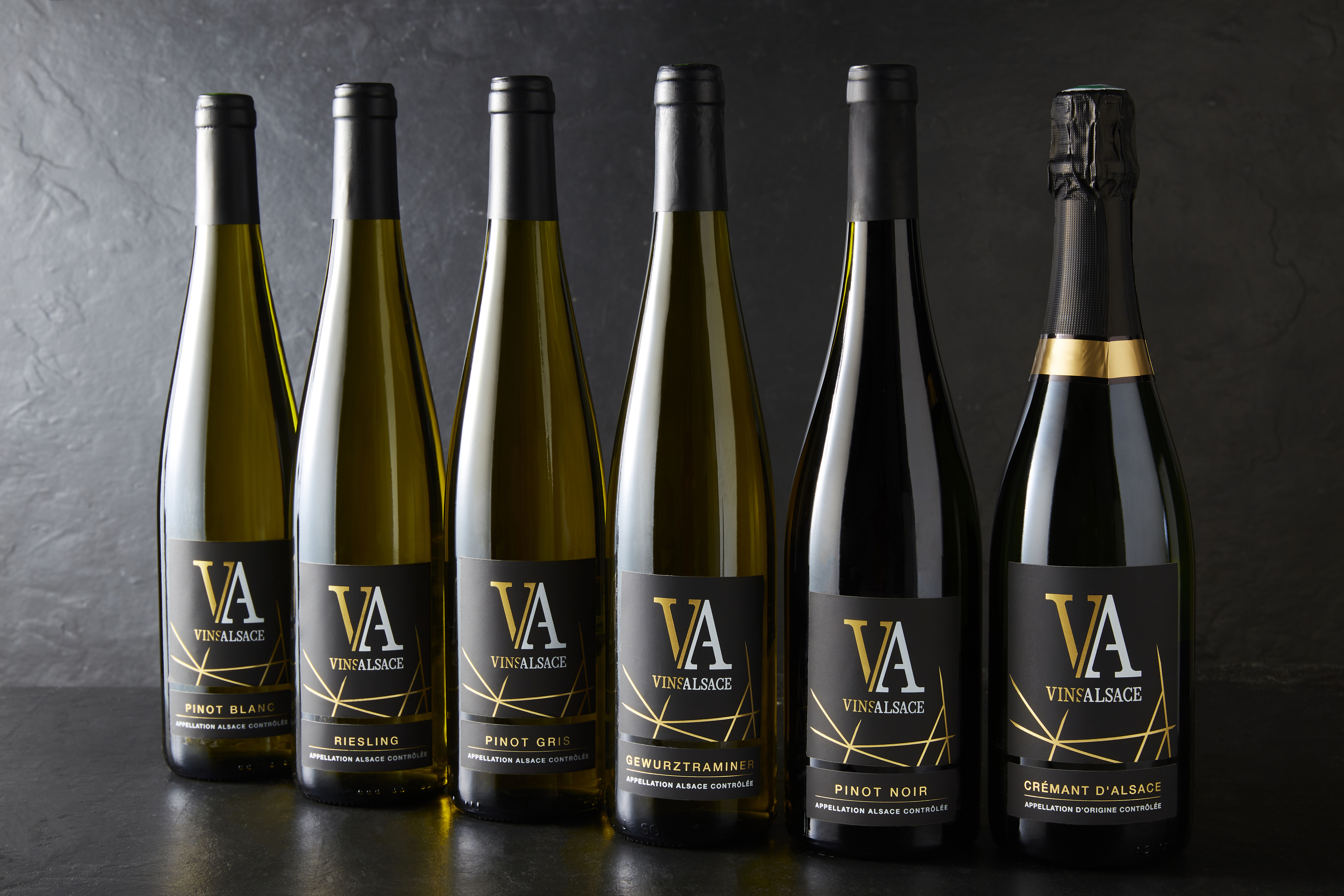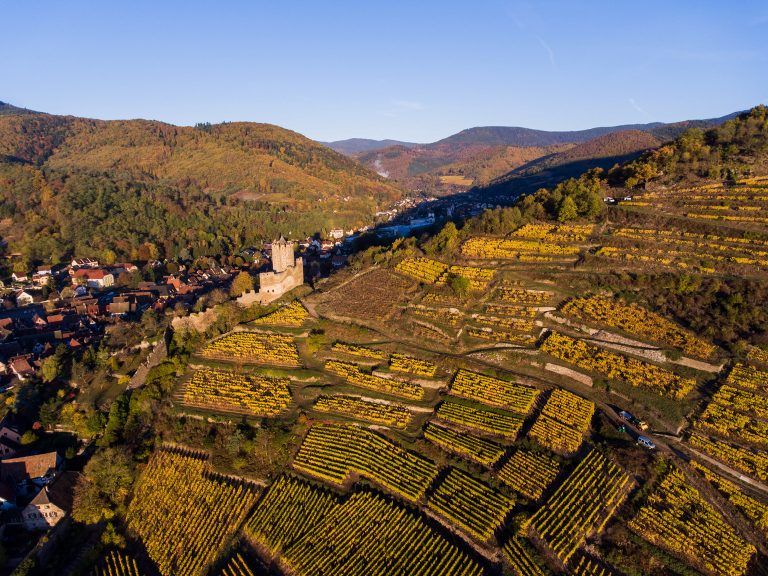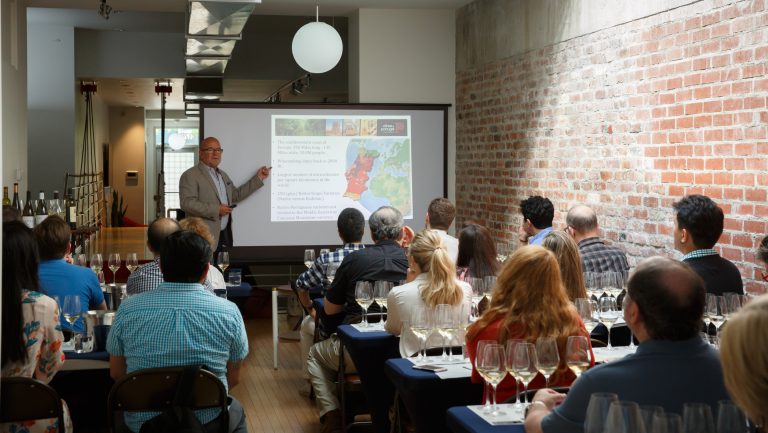This advertising content was produced in collaboration with our partner, Vins d’Alsace.
Few features define Alsace more than the Vosges Mountains lining the west, upon whose lower, geologically-complex slopes lie many of the region’s vineyards. The Vosges act as a barrier against the soggy climatic influences of the distant Atlantic Ocean, making Alsace one of the driest areas in France. To the east, lies the great Rhine River, which forms the once-fraught border with Germany.
This narrow, 80-mile long stretch of land produces wines that possess a remarkable tension and sense of purpose. They are also marked by an unusual duality, for while the tradition of labeling the wines by grape variety may seem more Germanic in nature, an overlay of placing primacy on Grand Cru-ranked and lieu-dit named vineyards leaves no doubt that these are French wines of terroir through and through.
On-premise, this leads to a perfect combination: guests can easily identify the wines they are drinking by grape variety (e.g. Riesling, Pinot Gris, Pinot Noir, and more), while celebrating the French tradition of terroir-focused viticulture.

Don’t miss the latest drinks industry news and insights. Sign up for our award-winning newsletters and get insider intel, resources, and trends delivered to your inbox every week.
“I find the region to be fascinating for a number of reasons,” says Jenni Wagoner, sommelier and wine director of noted Chicago hotspots, Sepia and Proxi. “The rich history of Alsace combined with its idyllic setting makes it an exciting place to share with guests.”
As sommeliers continue to look for versatile wines that unquestionably reveal their origins, Alsace frequently comes out on top. Here is how three top sommeliers have embraced Alsace wines and the effort to educate consumers on why Alsace rocks.
Soil and Climate
“There is almost nowhere in the world where a single variety can successfully and happily be harvested at so many different levels of maturity,” says Master Sommelier Josh Nadel, who is the beverage director at NoHo Hospitality in New York City.
Because of their broad price range and versatility, Alsace wines have become an essential feature of Nadel’s wine list, including regular dry and sweet by-the-glass options. “The spectrum of flavors has something for everyone and every dish,” he adds.
This variety stems from an incredible diversity in the terroir of Alsace, which is present at all levels of Alsace wine: from entry-level Alsace AOC wines to Crémant d’Alsace to the iconic Alsace Grand Cru.
Vineyards draw their unique and often divergent character from up to 13 different soil types — a geological wealth that is unheard of in other French wine regions. Just within the Riesling category, for example, you can explore the verve and smoky aromas of volcanic terroir, the ample concentration lent from granitic soil, or the firm yet elegant structure conveyed from shale.
But, Nadel offers a word of caution: “Guests in your restaurant may not actually taste the difference between clay and schist, however, it is an awesome talking point and educational vehicle.”
Matthew Kaner, the wine director and president of Will Travel for Wine, Inc., likens Alsace’s geological diversity to a “spice cabinet” that winemakers can call upon to seek out different expressions of single varieties.
“You can find many wines from Alsace with varying levels of residual sugar,” Kaner says. “But they will always have [acidity] that shows freshness and works so well in food pairings.”
Versatility at the Table
In Alsace, the bond between wine and food is unbreakable. Winemakers are as likely to discuss the gastronomical properties of their wines as they are the techniques they employ in the cellar, and this commitment shines in every glass.
“When speaking about wines from Alsace, I always circle back to their food-friendly nature,” remarks sommelier Jenni Wagoner. Because of their ease with savory, spicy, umami, and rich flavors, Wagoner always has an Alsace wine by the glass at each of her restaurants.
“The offering of [Alsace] wines in this way tends to open the door for guests exploring more wines from the region. We have gotten such positive feedback that I have a small section in the Sepia list that is dedicated solely to Alsace’s wines.”
Of particular note for Wagoner are Alsace’s Pinot Gris — which she has developed an affinity for because of their textural richness — as well as Alsace’s powerful dry Rieslings, which she considers to be one of the most versatile wines on her menu in terms of pairing. “Also, Gewurztraminer pairs beautifully with the India-inspired dishes at Proxi,” she adds. “And we often have them available by the glass for guests to try.”
Cultivating Guest Receptivity
While a sommelier’s passion for a specific wine region can be enough to sell a few bottles, sustained success only comes from consistent guest receptivity. For sommelier Jenni Wagoner, Alsace’s wines have become a mainstay on her wine list because they balance accessibility with complexity.
“American consumers tend to be more comfortable when there is a variety on the label,” she observes. “It equates to more familiarity and willingness to experience a version of something that they recognize.”
Sommelier Matthew Kaner agrees. “So many great wines from France (and other parts of Europe) are named by their village or vineyard. While that’s understood by wine aficionados and connoisseurs alike, having the grape variety clearly written on the labels does take the guessing out of it for the average consumer.”
Kaner also notes that Alsace is rich with stories, from its tumultuous past through multiple wars, to the individual acts of winemakers looking to preserve their multi-generational family traditions. “I love telling these stories to guests,” he says.
But in the end, the wines must be delicious, and in that regard, Master Sommelier Josh Nadel notes, Alsace delivers every time.
“Guests are often surprised at how much they love them, and they love them with their food,” he says.

Dispatch
Sign up for our award-winning newsletter
Don’t miss the latest drinks industry news and insights—delivered to your inbox every week.











